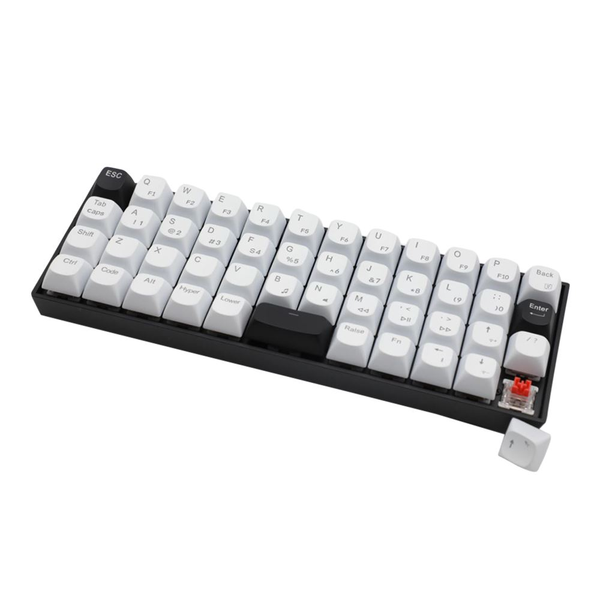Review of the MK-47
Posted
As I stated in a previous post, I am currently getting into the world of minimal keyboards. I'm currently using the MK-47, a minimal store brand keyboard that costs $50 at MicroCenter, though I just got in a Ferris Sweep. I will review this later.
I'll be honest, when I started using this keyboard, I thought it would just be a way to test if something smaller than 60% would work for me, but it grew on me to the point where I consider it an essential part of my workflow now.
What I like about this keyboard
Compared to most mechanical keyboards, the MK-47 is cheap. Like, really really cheap. Again, $50 including RGB lighting, mediocre no-name red switches, and keycaps. It is also assembled, rather than a kit. Honestly, I don't know how they afford this.
The MK47 states that it comes powered by QMK and supports VIA. It may be powered by QMK, but I had no luck flashing it, nor did anyone on Reddit that I was able find. The normal VIA app does not work with it either but it didn't take much digging to find that https://via.evove.top/ works well. This is the first programmable keeb I've owned, and I am not going back! I set it to Colemak (which I learned about two months ago and am still working at building speed and accuracy in), set a grid-layout numpad on my home row, and generally made a bunch of changes to make this keyboard my own.
I spent a lot of time working on a layout, taking bits and pieces of various "standards" like Miryoke, Callum, and others. I still make changes almost daily. I alternate between this and the Sweep, but as that one uses ZMK it requires a reflash (which I can't do on my work PC) to update. VIA makes iterating layouts a breeze.
I also really like the ortholinear layout. Instead of the stagger between rows all keys are in a grid, which makes finding some of the less-used keys easier. I am still relearning the bottom row as most of these keys are so far staggered in a traditional layout that I was using the incorrect fingering. But overall, the ortho layout makes it much easier to find keys and takes very little getting used to.
What I dislike
As stated before, this keeb does not support proper VIA or QMK flashing, which means the programmability is limited. I can set macros and layers, but can't add more than four layers (including the base layer), combos, mouse support, or many other things that I would be able to do if I could flash QMK directly to the keeb. I love the level of customization I have over my keymap, but it just makes me want to go further and I can't. I also can't set the ModTap hold time, which makes home row mods nearly unuseable. However, the longer I used this keeb, the more these limitations seemed less limiting.
I don't have a lot of experience with keyswitches, but know that I don't care much for these. However, they are hot-swappable so I can change them out. The keycaps were not only ugly, but also sculpted so I can't move them to match my Colemak layout. I ordered some SDA profile caps which do not diffuse the beautiful RGB lighting as well but are comfortable and do what I need.
I have also been playing with a 34 key layout that would be better served by two 1 unit spacebars than with a 2 unit one, similar to what I previously outlined.
Where I plan to go from here
I didn't plan to use this board forever, but after the way it has grown on me, I just might. It was the cheapest intro I could find to ortho keyboards and smaller keyboards, so I could see if I wanted to invest in either. I plan to continue with both. I tried to build a Contra kit but it did not work. However, the layout I am currently using is only 34 keys, so I purchased a prebuilt Ferris Sweep. I had been planning to give my MK47 to a coworker that was interested in ortho once my next keeb came in, but this has become so important to my workflow I no longer am willing to part with it.
Final thoughts
This keyboard was not intended as an endgame, but over a month or two it surprised me with how wonderful it is. If you get one, you must customize the layout. The default is trash. However,you will find that the more personalized you make this keeb, the more it becomes essential to your workflow, and that workflow will begin to include changing the layout to match what you are doing.